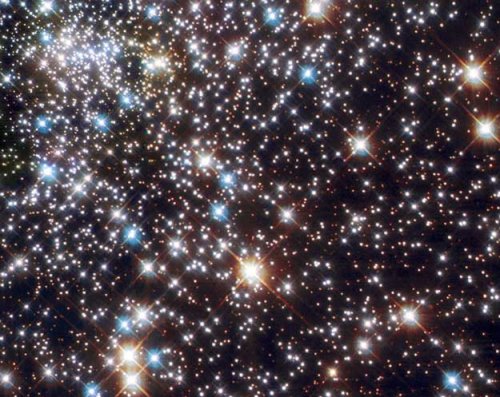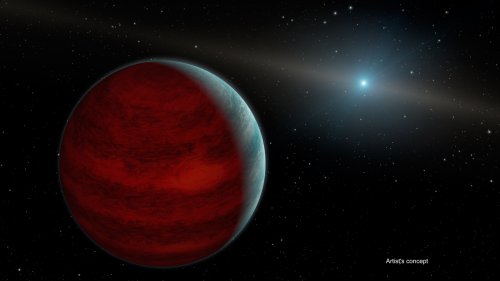Objects that seem younger than they ought to be attract attention. Take the so-called ‘blue stragglers.’ Found in open or globular clusters, they’re more luminous than the cluster stars around them, defying our expectation that stars that formed at about the same time should develop consistent with their neighbors. Allan Sandage discovered the first blue stragglers back in 1953 while working on the globular cluster M3. Because blue stragglers are more common in the dense core regions of globular clusters, they may be binary stars that have merged, but a number of theories exist, most of them focusing on interactions within a given cluster.

Image: The center of globular cluster NGC 6397, in an image taken by the Hubble Space Telescope. Credit: Francesco Ferraro (Bologna Observatory), ESA, NASA.
Now we may have found a planet that seems to be younger than it ought to be. Michael Jura (UCLA) and team report on the results in the Astrophysical Journal Letters, making the case that a planet orbiting an aging red giant may feed off mass flowing outward from its dying primary. A red giant can lose half its mass or more as it makes the transition to white dwarf, with sheets of material flowing into the outer system where aging gas giants may lurk.
Thus the white dwarf PG 0010+280, noted for its unexpectedly bright infrared signature in data UCLA student Blake Pantoja examined from the WISE (Wide-field Infrared Survey Explorer) mission. Spitzer observations from 2006 confirmed the excess of infrared, which could come from a small companion star — conceivably a brown dwarf — or a planet that has been rejuvenated by the inflow. The paper is careful to examine a range of alternatives, but further work is definitely called for given that this might represent planetary survival after the red giant phase.
At this point, we don’t have a good understanding of how common planets are around white dwarfs. Direct imaging has turned up a large gas giant at about 2500 AU orbiting the white dwarf WD 0806-661, and we also have theoretical calculations showing that planets can survive a red giant phase and remain in orbit around a white dwarf if they’re more than several AU out. Systems like this look to be unstable, with surviving minor planets eventually accreting onto the white dwarf to produce an enriched stellar atmosphere or a disk around the star.

Image: This artist’s concept shows a hypothetical “rejuvenated” planet — a gas giant that has reclaimed its youthful infrared glow. NASA’s Spitzer Space Telescope found tentative evidence for one such planet around a dead star, or white dwarf, called PG 0010+280 (depicted as white dot in illustration). Credit: NASA/JPL-Caltech.
Digging around in the new paper, I learn that we find dust disks around about four percent of white dwarfs, with all of those so far studied also showing an atmosphere enriched with heavy elements like oxygen, magnesium, silicon and iron. These elements have been assumed to be leftover materials from asteroids pulled apart by gravitational forces. An excess at infrared wavelengths is one way researchers have looked for low-mass companions around white dwarfs, and the first assumption about PG 0010+280 surely went in the same direction.
But as we learn, this is one white dwarf that does not fit the model for asteroid disks well. PG 0010+280 shows an infrared excess but no sign of heavy elements. From the paper:
Its unique infrared color as well as the non-detection of heavy elements with high-resolution spectroscopic observations suggest a possible alternative origin than white dwarfs with infrared excess from a circumstellar disk. From fitting the SED [Spectral Energy Distribution], we can not exclude models of either an opaque dust disk within the tidal radius or a substellar object at 1300 K, from an irradiated object or a re-heated planet. Future observations, particularly with spectroscopic observations in the ultraviolet and near-infrared, could reveal the nature of the infrared excess.
To fit the data, a cool brown dwarf would need a radius too small to produce the observed infrared excess, while a hot brown dwarf (re-heated during the red giant phase) would be too hot. A re-heated giant planet remains a real possibility, and the paper adds that spectroscopy in the near-infrared might be able to detect the signature of such a world, whose rejuvenation would leave a huge amount of dust in its atmosphere. “Due to possible accretion of carbon-rich material, the composition of the object’s atmosphere could be substantially modified and display CH4 and CO.”
A gas giant like the one hypothesized here would be about ten times the size of its primary — white dwarfs are about the size of the Earth, and as this JPL news release notes, such a star would be small enough to easily fit inside the Great Red Spot on Jupiter.
The paper is Xu et al., “A Young White Dwarf with an Infrared Excess,” Astrophysical Journal Letters Vol. 806, No. 1 (abstract / preprint). Thanks to Ashley Baldwin for the pointer on this one.



Correct me if I am wrong, But I thought planets (albeit NOT intact gas giants) WERE proven to survive the red giant phase of stellar evolution. Case in point:Kepler 70b,c,(d?) AND Kepler 429b,c,d. But, why I am REALLY writing this comment, is, that the article did DOT constrain a LOCATION for the “blackbody” . This leads to the intreguing possibility, HOWEVER SLIM, that the “blackbody” is either some kind of Dyson shell, or, even more interesting, a Dyson sphere CURRENTLY under construction (I would favor the “shell” interpretation, just because of the lack of metals). I know that an EARLIER posting on this website dealt with this issue. I would appreciate some feedback from commentators on THAT posting. Specifically, what percentage of PG 0010-280 is being occulted by the shell(probably not much)>
OOPS! When I wrote “…dealt with this issue” I did not mean PG 0010-280 SPECIFICALLY, but Dyson spheres around white dwarfs IN GENERAL.
Did they consider this as a possible Dyson sphere / swarm?
As a by the way, I am by no means convinced that a Dyson object would be a near perfect black body (at some appropriate waste heat temperature). I would actually expect a range of stuff doing things at different temperatures and (given the nature of a swarm), that means at a distance there would be a combination of a bunch of different black bodies (much like a natural dust cloud behaves). So, just saying that “IR source X is not a black body” is not IMO really conclusive as to whether it is a Dyson object or not.
I wonder why only 4% of WDs host dusty discs? Kepler data has given us some bounds on the high proportion of stars that host planets and as WDs are the end stages of stars with a ‘narrow’ range of masses, Sol being in there too, I would (naively) expect more.
Does the disc survive the PN phase or do they form afterwards? It would be interesting to know…
1. What % of WDs show no signs of contaminated photospheres and no signs of dust discs,
2. How many show contamination but no disc (assumed system has totally collapsed onto WD (with some expelled due to pressure from increased UV emission)
3. How many show little, to no contamination, yet hosts a disc
Of course, this could also be evidence of a KII ETI experiment to see if they can uplift planets before moving on to Brown Dwarfs, Red Dwarfs and larger stars ;D
I would have thought a magnetic field would have diverted a lot of the material around the planet heating it though thermal emissions but not accrete it. If the planet spins on it side like Uranus the magnetic field could pull a significant amount of material onto it by magnetic funnelling. I have long suspected planets including our own gas giants will attract a lot of mass during a red giant phase potentially reheating them, their moons though may be completely boiled away or broken up into dusty rings around them.
1 of my first blog posts was an idea that in the centers of some planets might for a time harbor a natural fission reactor and this might account for some planets seemingly being to warm for their age or size
None of the models seem to fit well with the data. They definitely need more data to exclude some hypotheses. These are some interesting possible locales to add to the SF settings zoo.
Thanks Paul. Informative radiation is infrared. Not nearly so easily absorbed as visible light , ” extinction” as it’s known . The ELTs of next decade have a plethora of sensitive infrared based sensors that will really drive forward discovery with this wavelength hopefully with more such exciting discoveries and as astronomers always hope, lots of unexpected ones. Rumsfeldts “unknown unknowns ” no less. Meantime of course we will have the near exclusive infrared space based JWST that has so much much hope held in novel exoplanet discoveries especially in conjunction with TESS and the even more exciting wide field WFIRST scope of 2024 which might be the first to accurately constrain exoplanets by astrometric method in tandem with Gaia , especially if the latter’s primary mission extends to near ten years providing unprecedented accuracy especially in synergy with WFIRST . After years of waiting this represents a ground breaking development in exoplanet discovery , possibly determining the position , radius and mass of all Earth sized planets within several tens of parsecs of Earth, many of which its coronagraph will allow direct imaging of as well as further determination by some of the more exotic software on the ELTs ! Expect an enlightening article on this from mission scientist David Spergel in next months arXiv. Ignas Snellen of Leiden University and lead for the METIS first generation instrument on the E-ELT which combines high dispersion spectroscopy with high contrast imaging and polarimetry ( as advanced a way of finding exoplanets from the ground to yet be employed utilising the huge apertures to maximum effect) will also be writing on this . Lots to look forward too when it comes to infrared and you saw it first on Centauri Dreams ! Well done Paul !
ALEX TOLLEY: “None of the models seem to fit well with the data. They definately need more data to exclude some hypotheses”. Is one of the “models” you are referring to, the ASSUMPTION of this infrared excess BEING “blackbody radiation”? Marshall Eubanks put a pretty big hole in my Dyson sphere/shell conjecture, unless the radiation ISN’T of a blackbody nature. RSVP. Marshall: OBVIOUSLY Dyson spheres or shells were NOT considered in the authors’ paper. Top of the line scientists would NEVER even put the POSSIBILITY of an ASTRONOMICAL non-natural solution in writing until ALL OTHER HYPOTHESES HAVE BEEN SUMMARILY REJECTED! That’ why it was so suprising to me when Michael Hippke even MENTIONED “ET” in his FRB paper. BUT: that doesen’t mean that these authors do not consider Dyson spheres/shells to be an exceedingly slim possibility if all of the models Alex is talking about fall out of favor when more data is obtained.